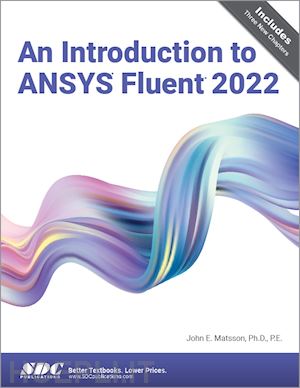As an engineer, you may need to test how a design interacts with fluids. For example, you may need to simulate how air flows over an aircraft wing, how water flows through a filter, or how water seeps under a dam. Carrying out simulations is often a critical step in verifying that a design will be successful. In this hands-on book, you’ll learn in detail how to run Computational Fluid Dynamics (CFD) simulations using ANSYS Fluent. ANSYS Fluent is known for its power, simplicity and speed, which has helped make it a world leader in CFD software, both in academia and industry. Unlike any other ANSYS Fluent textbook currently on the market, this book uses applied problems to walk you step-by-step through completing CFD simulations for many common flow cases, including internal and external flows, laminar and turbulent flows, steady and unsteady flows, and single-phase and multiphase flows. You will also learn how to visualize the computed flows in the post-processing phase using different types of plots. To better understand the mathematical models being applied, we’ll validate the results from ANSYS Fluent with numerical solutions calculated using Mathematica. Throughout this book we’ll learn how to create geometry using ANSYS Workbench and ANSYS DesignModeler, how to create mesh using ANSYS Meshing, how to use physical models and how to perform calculations using ANSYS Fluent. The chapters in this book can be used in any order and are suitable for beginners with little or no previous experience using ANSYS. Intermediate users, already familiar with the basics of ANSYS Fluent, will still find new areas to explore and learn. An Introduction to ANSYS Fluent 2022 is designed to be used as a supplement to undergraduate courses in Aerodynamics, Finite Element Methods and Fluid Mechanics and is suitable for graduate level courses such as Viscous Fluid Flows and Hydrodynamic Stability. The use of CFD simulation software is rapidly growing in all industries. Companies are now expecting graduating engineers to have knowledge of how to perform simulations. Even if you don’t eventually complete simulations yourself, understanding the process used to complete these simulations is necessary to be an effective team member. People with experience using ANSYS Fluent are highly sought after in the industry, so learning this software will not only give you an advantage in your classes, but also when applying for jobs and in the workplace. This book is a valuable tool that will help you master ANSYS Fluent and better understand the underlying theory. Topics Covered Boundary Conditions Drag and Lift Initialization Iterations Laminar and Turbulent Flows Mesh Multiphase Flows Nodes and Elements Pressure Project Schematic Results Sketch Solution Solver Streamlines Transient Visualizations XY Plot Animation Batch Job Cell Zone Conditions CFD-Post Compressible Flow Contours Dynamic Mesh Zones Fault-tolerant Meshing Fluent Launcher Force-Report Macroscopic Particle Model Materials Pathlines Post-Processing Reference Values Reports Residuals User Defined Functions Viscous Model Watertight-Geometry












